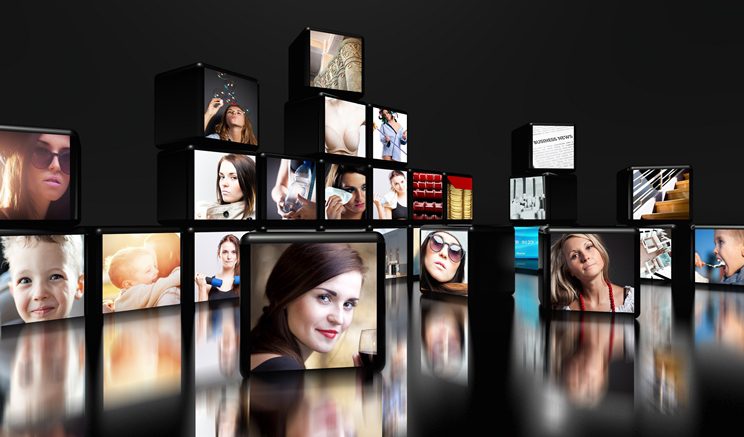According to Wikipedia, Social TV is the union of Social Media and TV. According to Mashable, the term refers to technologies surrounding television and according to Adage, the social TV ecosystem includes game consoles and on-air graphics. So which is it?
In the ever-expanding sector that stretches between digital and TV, there is still a considerable lack of clarity. Paradoxically, it leads to a parade of buzzwords being born and circulated in conferences. Social TV is a mega term that covers almost anything digital. One might say that it has a focus of audience engagement, but then again, anything digital that TV does aims at increasing audiences.
Following is a basic glossary explaining some of the most recurring terms of Social TV (in its broader sense).
Android – A mobile operation system developed by Google. In practicality this means that if you want your app to appear on a google enabled device (Samsung, LG, HTC phones, and almost all else except the Apple devices) you need to create an app that works on Android.
AVOD – Advertising-based Video on demand. (i.e. Hulu)
Big data – There is a ginormous amount of data constantly collected on the web; about people, about people’s habits, about things that are and were. The ability to gather that info and use it to come up with practical insight (or activity based on that insight) is one of the greatest pursuits of our day as it already is and will continue to affect every area of our lives.
Check in – An indication by the viewer that he is watching a certain show (at the time he is actually watching it). The check in encourages viewers to share what they are watching with friends, thus increase social hype. Users are incentivised to check-in via prizes or ranks.
Cloud services – Data storage (be it video files or office documents) and computing ability that occurs on a remote server (or a faraway computer) and can be accessed from a web browser. It allows us to access that data and use it regardless of where we are located (think Gmail or Dropbox).
Connected Devices – Any device that is connected to the internet has the potential of presetting choices to the viewer, receiving decisions, and responding in real time (in contrast to the one-way linear TV). Connected devices usually have processing powers already built in, so in order to use its platform you only need software development. This opens up a world of possibilities. (see “interactive advertising platforms” and “set top boxes”).
Cord Cutters – This term describes viewers who opt out of traditional television suppliers (MPVD) in favor of web-based video streaming.(for example, one might decide to stop using Cable bundles in favor of a Hulu Plus subscription).
Cross Media – Content on digital platforms that extends an experience, which is featured primarily on traditional platforms like TV and Film. Cross media content can be created for the sake of marketing, monetization, creativity etc.
Deep linking – This is the ability to send a “lead” (user clicking on banner or URL) straight into an inner page of a website or app, and not to the home page. Deep links are used a lot in online advertising, allowing you to publish a specific segment of your business (i.e. children’s programming) directly to a specific demographic (i.e. parents).
GIF – A format that displays 2-3 sec movies that are easily used across a range of websites and social networks. In TV, this is a format heavily used as very short promotion clip or content that the users can engage with and easily share.
Growth hacking – New product teams often have a lot of marketing research to do super quick with low resources. They need to check their market hypotheses fast but they are usually low on resources so they turn to growth hacking. These ever-evolving marketing techniques offer creative and out-of-the box tools to get a new product noticed and experienced in modest means and in a relatively short amount of time.
Hashtag – The hashtag sign # is really a tagging system that allows easy gathering of various posts under the same subject. The hashtag is written by the user that wants to add his two cents on a given subject and is built from the hashtag sign “#” followed by the relevant term (#superbowl or #Sherlock for example). It’s a way to gain and track social momentum by harnessing all activity under the same heading.
I-frame – Though there is usually one “brain” to control a specific web activity, its facade can appear in many places at once. Using I-frame allows a website to incorporate an application seamlessly into any given interface. It allows many entry points of the same activity.
Interactive advertising platforms- The promise of classic TV advertising is its mass media reach. The promise of online advertising is the targeting of relevant users. Interactive advertising platform try to bring the best of both worlds by enabling targeted commercials as part of a TV screen experience (via connected devices). Interactive advertising also looks to create new forms of ads that call for bigger and more active engagement with the viewers.
Internet of things – (IOT) Connected devices are not limited to computers and TVs. Watches, clothes, refrigerators and pretty much everything else can be potentially connected to everything else. In this world, our devices talk to each other and work together to fulfil designed missions. This is considered the third major digital development (after internet and smartphones) as it will affect all aspects of life.
IOS – A mobile operation system developed by Apple. In practicality this means that if you want your app to appear on the IPad or IPhone, you need to create an IOS app (that will be available on the app store).
IPTV – Internet Protocol TV – An allocated share of bandwidth that is dedicated solely for the streaming of video content. This allows for a steady viewing experience, usually accompanied with a dedicated VOD interface. Clients need to order and install services based on IPTV.
Live video apps – These are apps that broadcast a live video feed to many viewers over a web infrastructure. Mobile apps like meerkat and periscope allow people to broadcast moments and events of their lives, as they happen, straight from their social network profiles.
MCN – a collection of YouTube channels under one management. Getting a group of web talents under the same roof allows for cross promotion, production facilities that can be shared and a central management that can negotiate endorsement deals and better rates from Video sites. In essence it is the talent agency model designed for YouTube stars. Watch French MCN Golden Moustache’s showcase at MIPTV 2014:
[youtube]https://www.youtube.com/watch?v=t6DLq1CIQ0I&index=9&list=PLwwdjGwnXX8QjmKineKtzVNcNBSerxuI4[/youtube]
Meme – An idea that is born in one mind, than introduced to another mind where it replicates itself (often with a twist) before continuing to the next mind. The virus-like infection of ideas are often at the heart of a Viral phenomenon (think “Gangnam Style” or “let it go” immense popularity and user generated versions).
Metadata – The web can’t read images (for the most part), so text is how it categorizes and organizes the wealth of information. Metadata are the tags used to describe a piece of content. It not only allows us to find stuff online, but also to aggregate it and make various uses of it.
MPN – An evolution of the MCN model meaning Multi-Platform Network. MPN’s focus on IP and talent rather than on the monetization of the online platform. It allows MPN to keep managing IP and talent also when they operate outside of Youtube, in other media like TV, film and print.
Never cords – A term relating to people who will never consume and pay for content in the traditional way (MPVD). These people normally grew up with free access to the internet (i.e. Millenials and their children) and are most comfortable with new forms of content consumption.
New Media – “Media” is any platform that you can use to display content. It can be a TV, a book, a theater stage, a t-shirt you write on or a wall that has graffiti. “New” Media than, refers to new platforms introduced by the digital revolution and particularly: smartphones, tablets and PCs. This leads to “New Media content” as any content that’s targeted to those platforms.
OTT – Over the Top. This in reference to services that are provided online and can be accessed as part of your regular internet service. It makes it easy to use and approach but as the service (especially streaming) needs to take a share of a limited bandwidth, it’s quality is dependent on infrastructure, broadband penetration, amount of online devices used at one time etc.
Programmatic ads – The premise of online advertising has always been the ability to pinpoint the right user for a product at the right time. This is happening more and more as greater computing power becomes available to the masses and more data is collected across interconnected platforms. Automated and managed ad campaigns can now continuously examine, optimize and adapt with little to no human guidance.
Remote control apps – Just as it had done with the camera and flashlight, the smartphone is perfectly poised to make remote controls obsolete. The technology is there and so is the smartphone, in the hands of those watching TV. The remote control apps provides great opportunity for social and marketing activity, taking place on top of the interface.
Responsive design – People view the web in using many devices with different screens and sizes.. Responsive design is a programming doctrine for creating user interfaces that knows how to adapt to various display types in the optimal manner. This means that when you load a website, you’ll get a different arrangement of its content depending on the screen you are using.
SaaS – The creation of a functionality (a second screen app for example) is an expensive project, and one that needs constant updating, improvement, security monitoring etc. For most companies, all of this work is expensive and a outside of the scope of the company’s core skills. SaaS means that someone else is building and maintain the functionality and any number of companies can “rent” this service to use as its own with internal data and design (think Salesforce).
Second Screen Apps- Dedicated applications that feature specific interaction with TV content (answer the game show questions live, vote for your contestant). The specifically designed experience creates a richer multi-screen experience with greater control over real time effect, data gathered, advertising capabilities and more.
Set Top Boxes – Hardware units that can turn TV sets into connected devices. Usually comes with a branded VOD system and other interactive capabilities. (See “Connected Devices”).
Smart TV – A TV set that is connected to the internet and can provide video sent over the web as well as MVPD services (terrestrial, satellite etc) .The TV’s have built in computing powers and interfaces that allow for a wealth of opportunities for new VOD players, apps and interactive advertising platforms.
Social Enabled Devices – Devices, like smart TV or game consoles that are connected via the internet to social platforms. Now, the device knows your habits and your friend’s habits which allows for a social layer to be added. It can tell you what your friends’ are watching or how much you scored (in a game) compared to your peers.
Social EPG – Electronic Program guide that also carries information regarding social activities of featured shows. So not only it can tell you which show is on and where, but also how many are watching it right now.
Social Networks – Facebook, Twitter, Instagram, Pinterest and other platforms that are virtual meeting places for people who wish to do things that a community enables (discuss, share etc). Those are key for TV extensions as the mass audiences are already inhabiting and are active in this space. TV looking to interact with members of a specific platform, needs to integrate into modes and rules of that platform.
Streaming – When you watch video online you normally don’t get the whole file at first, but only a bit at a time as you view it. The video player handles small pieces of the video data in succession. This ‘chunk of data’ is sent from sources containing the full video file. This continuous reception and display of video data is called streaming. While getting cheaper and cheaper, streaming is still relatively expensive and constitutes the biggest expense of any video website.
SVOD – Subscription based Video on demand (i.e. Netflix; watch its chief content officer Ted Sarandos talk at MIPCOM 2014 below).
Syncing technologies – For the sake of a more holistic experience between the various screens, the second screens (like mobiles and tablets) need to know exactly what content is on the TV at a specific moment. Syncing technologies (like audio recognition) allow apps to “hear” what’s on TV and have the right voucher appear on the app while the same brand has a commercial on TV (turning awareness to action).
Transmedia – Storytelling models that were not possible before the digital revolution. It is a creative front that be a story that happens across both the digital and real worlds (like an ARG) or stories you need a programmer to execute (like interactive documentaries).
TV specific social Networks – Social networks designed to allow content creation by its members. This will usually be geared towards a content concept that requires many to participate.
Virtual Reality (VR) – An ability to experience a virtual world that is projected onto your surroundings, usually in the form of personal small screens designed to capture your entire viewing filed. Various devices such as helmets, goggles, headphones and wearable sensors can create immersive experiences and allow the user to interact with the virtual reality world
VPN – Virtual Private network – In essence this is a private network conducted on a public network (a work’s place internet that is built onto the World Wide Web). More importantly this allows people to surf from networks other that their own, which means they can watch geo blocked content, thus challenging the “sales by territory” model.
White Label platforms – Separating the software from the software’s brand allows it to easily integrate into the facade of a client’s brand. It’s like selling an engine that any car manufacturers can place under the hood of his own cars.
Daniel Ravner is the founder and CEO of cross-media firm Practical Innovation, and a frequent contributor to MIPBlog. Check out all of his posts here.
Top photo via Shutterstock – Leszek Glasner






1 Comment
Great and much appreciated contribution